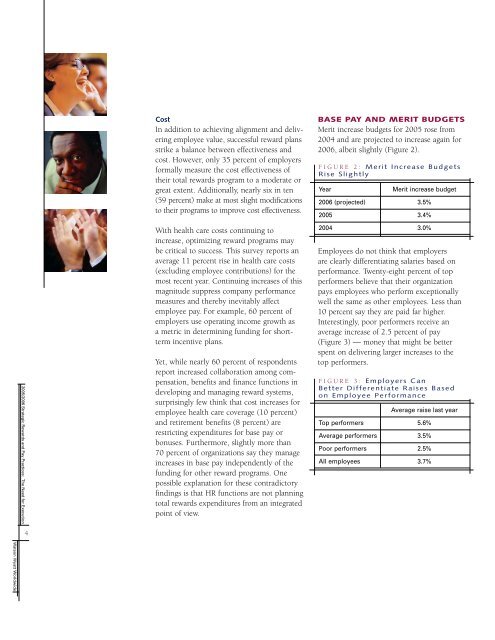The Need for Execution - San Antonio Compensation Association
The Need for Execution - San Antonio Compensation Association
The Need for Execution - San Antonio Compensation Association
Create successful ePaper yourself
Turn your PDF publications into a flip-book with our unique Google optimized e-Paper software.
Cost<br />
In addition to achieving alignment and delivering<br />
employee value, successful reward plans<br />
strike a balance between effectiveness and<br />
cost. However, only 35 percent of employers<br />
<strong>for</strong>mally measure the cost effectiveness of<br />
their total rewards program to a moderate or<br />
great extent. Additionally, nearly six in ten<br />
(59 percent) make at most slight modifications<br />
to their programs to improve cost effectiveness.<br />
BASE PAY AND MERIT BUDGETS<br />
Merit increase budgets <strong>for</strong> 2005 rose from<br />
2004 and are projected to increase again <strong>for</strong><br />
2006, albeit slightly (Figure 2).<br />
FIGURE 2: Merit Increase Budgets<br />
Rise Slightly<br />
Year<br />
Merit increase budget<br />
2006 (projected) 3.5%<br />
2005 3.4%<br />
2005/2006 Strategic Rewards and Pay Practices: <strong>The</strong> <strong>Need</strong> <strong>for</strong> <strong>Execution</strong><br />
With health care costs continuing to<br />
increase, optimizing reward programs may<br />
be critical to success. This survey reports an<br />
average 11 percent rise in health care costs<br />
(excluding employee contributions) <strong>for</strong> the<br />
most recent year. Continuing increases of this<br />
magnitude suppress company per<strong>for</strong>mance<br />
measures and thereby inevitably affect<br />
employee pay. For example, 60 percent of<br />
employers use operating income growth as<br />
a metric in determining funding <strong>for</strong> shortterm<br />
incentive plans.<br />
Yet, while nearly 60 percent of respondents<br />
report increased collaboration among compensation,<br />
benefits and finance functions in<br />
developing and managing reward systems,<br />
surprisingly few think that cost increases <strong>for</strong><br />
employee health care coverage (10 percent)<br />
and retirement benefits (8 percent) are<br />
restricting expenditures <strong>for</strong> base pay or<br />
bonuses. Furthermore, slightly more than<br />
70 percent of organizations say they manage<br />
increases in base pay independently of the<br />
funding <strong>for</strong> other reward programs. One<br />
possible explanation <strong>for</strong> these contradictory<br />
findings is that HR functions are not planning<br />
total rewards expenditures from an integrated<br />
point of view.<br />
2004 3.0%<br />
Employees do not think that employers<br />
are clearly differentiating salaries based on<br />
per<strong>for</strong>mance. Twenty-eight percent of top<br />
per<strong>for</strong>mers believe that their organization<br />
pays employees who per<strong>for</strong>m exceptionally<br />
well the same as other employees. Less than<br />
10 percent say they are paid far higher.<br />
Interestingly, poor per<strong>for</strong>mers receive an<br />
average increase of 2.5 percent of pay<br />
(Figure 3) — money that might be better<br />
spent on delivering larger increases to the<br />
top per<strong>for</strong>mers.<br />
FIGURE 3: Employers Can<br />
Better Differentiate Raises Based<br />
on Employee Per<strong>for</strong>mance<br />
Average raise last year<br />
Top per<strong>for</strong>mers 5.6%<br />
Average per<strong>for</strong>mers 3.5%<br />
Poor per<strong>for</strong>mers 2.5%<br />
All employees 3.7%<br />
4<br />
Watson Wyatt Worldwide


